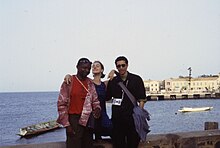Mounir Fatmi | |
|---|---|
 Mounir Fatmi | |
| Born | 1970 |
| Nationality | Moroccan |
| Known for | Contemporary art |
Mounir Fatmi (born 1970 in Tangier, Morocco) is a Moroccan artist. His multimedia practice encompasses video, installation, drawing, painting and sculpture, and he works with obsolete materials.[1]
Born in the city of Tangiers, he spent a majority of his time the neighborhood of Casabarata. This neighborhood was known as one of the poorest in the city. He would often spend his time in the flea market, where his mother made a living by selling children's clothing. It was in this very environment that he found himself surrounded by commonly used objects and waste products. [2]
As a young boy, he traveled to Rome where he studied at the free school of nude drawing and engraving at the Academy of Arts, and then later at the School of Fine Arts in Casablanca, Morocco (1989), School of Fine Arts, Rome, Italy (1991),[3] and finally studied at the Rijksakademie in Amsterdam. [4]
In 2006, he won the Uriöt prize, the grand prize of the Dakar Biennial and the Cairo Biennial Award in 2010.[5]
In 1993, Fatmi received first prize at the Third Biennial of Young Moroccan Painting, for the "Fragile / Communication" series and met Catherine David.[6]
In 1995, he becomes known outside of Morocco from his work with videos. He was selected at the International Videokunstpreis at the ZKM3 in Karlsruhe.[7]

In 1999, he met curator Jean-Louis Froment and participated in the exhibition "L'objet désorienté"[8][unreliable source?] at the Museum of Decorative Arts in Paris, where he made the sculpture Connections.
In 2004, Fatmi was invited by Simon Njami and Jean-Hubert Martin to participate in the exhibition "Africa remix" at the Kunstpalast museum in Düsseldorf, the Hayward Gallery in London, the Georges Pompidou Center in Paris, the Mori art museum in Tokyo, the Moderna museum in Stockholm, and the Johannesburg Art Gallery in Johannesburg.[9][verification needed]
Fatmi held his solo exhibition "Fuck architects, chapter I" at the Lombard project in New York.[10]
Fatmi began experiencing censorship in 2011.[11]
His work Modern Times, a History of the Machine is selected for the Jameel Prize 3 of the Victoria & Albert Museum in London, in 2013, and is exhibited in group shows related to this award at the Hermitage-Kazan Exhibition Center, the Moscow Manege, the Sharjah Museum of Islamic Civilization, and the National Library of Singapore.[12][failed verification]
In 2016, he launched The Exile Pavilion and organized the first stage at the National Archives Museum in Paris. He was selected for the exhibition "Fundamental" at the Fifth Mediations Biennale of Poznan[13] and for the Triennial of Setouchi Awashima Community Area[14] in Japan. In 2017, he participates in the exhibition The Absence of Paths: 1st Tunisian Pavilion at the 57th Venice Biennale.[15][non-primary source needed]
Fatmi's videos, installations, drawings, paintings and sculptures are influenced by issues related to identity, religion, multiculturalism, consumerism, the ambiguities of language, and the importance of communication.[16] He creates political art through the deconstruction of dead media, which represents the crumbling industrial and consumerist civilization.[17] In his work, he uses materials such as antenna cables, copier machines, old typewriters, VHS tapes, saw blades, books, and flags, in order to create compelling compositions.[18]
Fatmi's installations and films have the specificity to be produced with archaic and outdated material, such as VHS tapes.[19] Many of Fatmi's works are seen as subversive,[20] such as his Brainteaser for moderate Muslims, a series of Rubik's Cubes painted in black with white stripes to imitate the Kaaba in Mecca.[21] As a reaction to the Arab Spring, he exhibited The Lost Spring.[22]
Mounir Fatmi has had many solo shows to showcase his work, starting in 2006 up until 2021. All listed below have been at galleries, museums or institutions across the world.
2021
2018
2015
2014
2013
2012
2010
2007
2006
Mounir Fatmi has participated in many group exhibitions, starting in 2017 up until 2021.
2021
2020
2018
2017